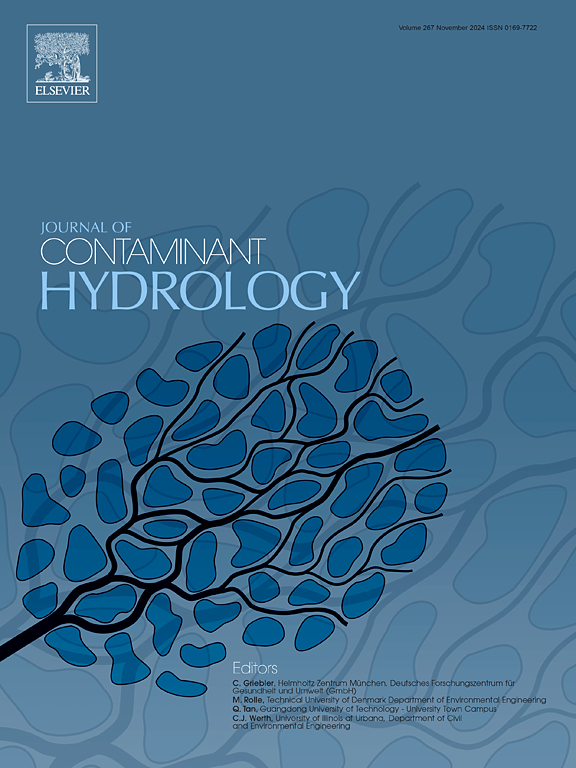Traceability analysis and risk assessment of river antibiotics based on dissolved organic matter spectral features and the positive matrix factorization receptor model
IF 3.5
3区 环境科学与生态学
Q2 ENVIRONMENTAL SCIENCES
引用次数: 0
Abstract
Identifying pollution sources is crucial for controlling antibiotic contamination and preventing risks to aquatic environments. This study quantified four categories of antibiotics (quinolones,macrolides, sulfonamides, and tetracyclines) in Dafeng River during the dry season using SPE-UHPLC-MS,analyzing their sources and risks. The source apportionment results for antibiotics using the Positive Matrix Factorization (PMF) model were validated against those identified based on Dissolved Organic Matter (DOM) fluorescence characteristics. Redundancy Analysis (RDA) was employed to clarify the relationship between specific source risks in the PMF model and DOM fluorescence characteristics. The findings include: (1) A total of 43 antibiotics were detected, with concentrations ranging from 19.04 to 1037.11 ng/L. The overall significant risk rate (RQ ≥ 0.01) was 55.1 %. (2) Excitation-Emission Matrix coupled with Parallel Factor Analysis (EEM-PARAFAC) identified three fluorescence components in the watershed's water body DOM: fulvic-like (C1), humic-like (C2), and tyrosine-like (C3). (3) The PMF model identified five pollution sources for antibiotics. Livestock discharge was the predominant source of concentration, while sewage treatment plants posed the primary source risk, consistent with the DOM spectroscopy results. (4) The RDA demonstrated a close relationship between DOM fluorescence characteristics and specific source risks of antibiotics.

基于溶解有机质光谱特征和正矩阵分解受体模型的河流抗生素溯源分析与风险评估
识别污染源对于控制抗生素污染和预防水生环境风险至关重要。本研究采用SPE-UHPLC-MS对大丰河枯水期4类抗生素(喹诺酮类、大环内酯类、磺胺类和四环素类)进行定量分析,分析其来源和风险。利用正矩阵分解(Positive Matrix Factorization, PMF)模型与基于溶解有机物(Dissolved Organic Matter, DOM)荧光特征识别的抗生素源解析结果进行了对比验证。采用冗余分析(RDA)明确PMF模型中特定源风险与DOM荧光特性之间的关系。结果表明:(1)共检出43种抗生素,浓度范围为19.04 ~ 1037.11 ng/L;总显著风险率(RQ≥0.01)为55.1%。(2)激发-发射矩阵耦合平行因子分析(EEM-PARAFAC)在流域水体DOM中鉴定出三种荧光成分:富里酸样(C1)、腐殖质样(C2)和酪氨酸样(C3)。(3) PMF模型识别出5个抗生素污染源。畜禽排放是主要的浓度源,污水处理厂是主要的浓度源,与DOM光谱结果一致。(4) RDA显示DOM荧光特征与抗生素特定来源风险密切相关。
本文章由计算机程序翻译,如有差异,请以英文原文为准。
求助全文
约1分钟内获得全文
求助全文
来源期刊

Journal of contaminant hydrology
环境科学-地球科学综合
CiteScore
6.80
自引率
2.80%
发文量
129
审稿时长
68 days
期刊介绍:
The Journal of Contaminant Hydrology is an international journal publishing scientific articles pertaining to the contamination of subsurface water resources. Emphasis is placed on investigations of the physical, chemical, and biological processes influencing the behavior and fate of organic and inorganic contaminants in the unsaturated (vadose) and saturated (groundwater) zones, as well as at groundwater-surface water interfaces. The ecological impacts of contaminants transported both from and to aquifers are of interest. Articles on contamination of surface water only, without a link to groundwater, are out of the scope. Broad latitude is allowed in identifying contaminants of interest, and include legacy and emerging pollutants, nutrients, nanoparticles, pathogenic microorganisms (e.g., bacteria, viruses, protozoa), microplastics, and various constituents associated with energy production (e.g., methane, carbon dioxide, hydrogen sulfide).
The journal''s scope embraces a wide range of topics including: experimental investigations of contaminant sorption, diffusion, transformation, volatilization and transport in the surface and subsurface; characterization of soil and aquifer properties only as they influence contaminant behavior; development and testing of mathematical models of contaminant behaviour; innovative techniques for restoration of contaminated sites; development of new tools or techniques for monitoring the extent of soil and groundwater contamination; transformation of contaminants in the hyporheic zone; effects of contaminants traversing the hyporheic zone on surface water and groundwater ecosystems; subsurface carbon sequestration and/or turnover; and migration of fluids associated with energy production into groundwater.
 求助内容:
求助内容: 应助结果提醒方式:
应助结果提醒方式:


